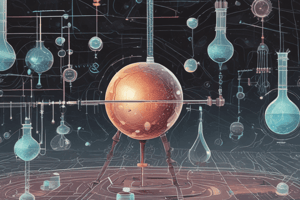Podcast
Questions and Answers
What is the relationship between the volume and pressure of a gas at constant temperature?
What is the relationship between the volume and pressure of a gas at constant temperature?
- Volume remains constant regardless of pressure
- Volume varies inversely with pressure (correct)
- Volume is directly proportional to pressure
- Volume increases as pressure increases
How does the volume of a gas change with an increase in temperature at constant pressure?
How does the volume of a gas change with an increase in temperature at constant pressure?
- Volume increases (correct)
- Volume decreases
- Volume fluctuates randomly
- Volume remains constant
What unit is used in the SI system to measure pressure?
What unit is used in the SI system to measure pressure?
- Atmosphere (atm)
- Pascal (Pa) (correct)
- Newton (N)
- Millimeter of mercury (mmHg)
Which of the following laws states that pressure and temperature are directly proportional for a gas at constant volume?
Which of the following laws states that pressure and temperature are directly proportional for a gas at constant volume?
Which formula correctly represents the relationship between pressure and volume according to Boyle's Law?
Which formula correctly represents the relationship between pressure and volume according to Boyle's Law?
What is the relationship between pressure and volume for an ideal gas at constant temperature?
What is the relationship between pressure and volume for an ideal gas at constant temperature?
According to Charles' law, how does volume relate to temperature at constant pressure?
According to Charles' law, how does volume relate to temperature at constant pressure?
What is the purpose of Avogadro's law in gas calculations?
What is the purpose of Avogadro's law in gas calculations?
How do you calculate the molar mass of a gas using its density?
How do you calculate the molar mass of a gas using its density?
At standard temperature and pressure (STP), what volume does 1 mole of an ideal gas occupy?
At standard temperature and pressure (STP), what volume does 1 mole of an ideal gas occupy?
What does Dalton’s law of partial pressures allow us to calculate?
What does Dalton’s law of partial pressures allow us to calculate?
If the pressure of a gas increases while keeping the temperature constant, what happens to the volume of the gas?
If the pressure of a gas increases while keeping the temperature constant, what happens to the volume of the gas?
Which equation represents the Ideal Gas Law?
Which equation represents the Ideal Gas Law?
Flashcards are hidden until you start studying
Study Notes
Gases
- Elements that exist as gases at 25°C and 1 atmosphere are:
- Hydrogen (H₂)
- Nitrogen (N₂)
- Oxygen (O₂)
- Fluorine (F₂)
- Chlorine (Cl₂)
- Helium (He)
- Neon (Ne)
- Argon (Ar)
- Krypton (Kr)
- Xenon (Xe)
- Radon (Rn)
Physical Characteristics of Gases
- Gases assume the volume and shape of their containers.
- Gases are the most compressible state of matter.
- Gases will mix evenly and completely when confined to the same container.
- Gases have much lower densities than liquids and solids.
Pressure
- Pressure is defined as force exerted per unit area.
- Units of pressure:
- SI unit: Pascal (Pa)
- 1 Pa = 1 N/m²
- 1 atm = 760 mmHg = 760 torr
- 1 atm = 101,325 Pa = 101.325 kPa
Gas Laws
- Boyle's Law: The volume of a given amount of gas held at constant temperature varies inversely with applied pressure.
- Mathematical representation: P₁V₁ = P₂V₂ (T and n are constant)
- Charles's and Gay-Lussac's Law: The volume of a given amount of gas held at constant pressure is directly proportional to the Kelvin temperature.
- Mathematical representation: V₁/T₁ = V₂/T₂ (P and n are constant)
- Temperature must be in Kelvin: T(K) = t(°C) + 273.15
- Amonton's Law: The pressure of a given amount of gas held at constant volume is directly proportional to the Kelvin temperature.
- Mathematical representation: P₁/T₁ = P₂/T₂ (V and n are constant)
- Avogadro's Law: The volume of a given amount of gas held at constant temperature and pressure is directly proportional to the number of moles of the gas.
- Mathematical representation: V₁/n₁ = V₂/n₂
Ideal Gas Equation
- Combines Boyle's, Charles's, and Avogadro's Laws:
- PV = nRT
- R is the ideal gas constant: 0.082057 L atm/(mol K)
- Standard temperature and pressure (STP) is defined as 0°C (273.15 K) and 1 atm.
- At STP, 1 mole of an ideal gas occupies 22.414 L.
Gas Density Calculations
- Density (d) of a gas is calculated using:
- d = (PM) / (RT)
- Molar mass (M) can be calculated from: M = (dRT) / P
Dalton's Law of Partial Pressures
- The total pressure of a mixture of gases is the sum of the partial pressures of each individual gas.
- Ptotal = P₁ + P₂
- V and T of the gases must be constant.
Studying That Suits You
Use AI to generate personalized quizzes and flashcards to suit your learning preferences.





